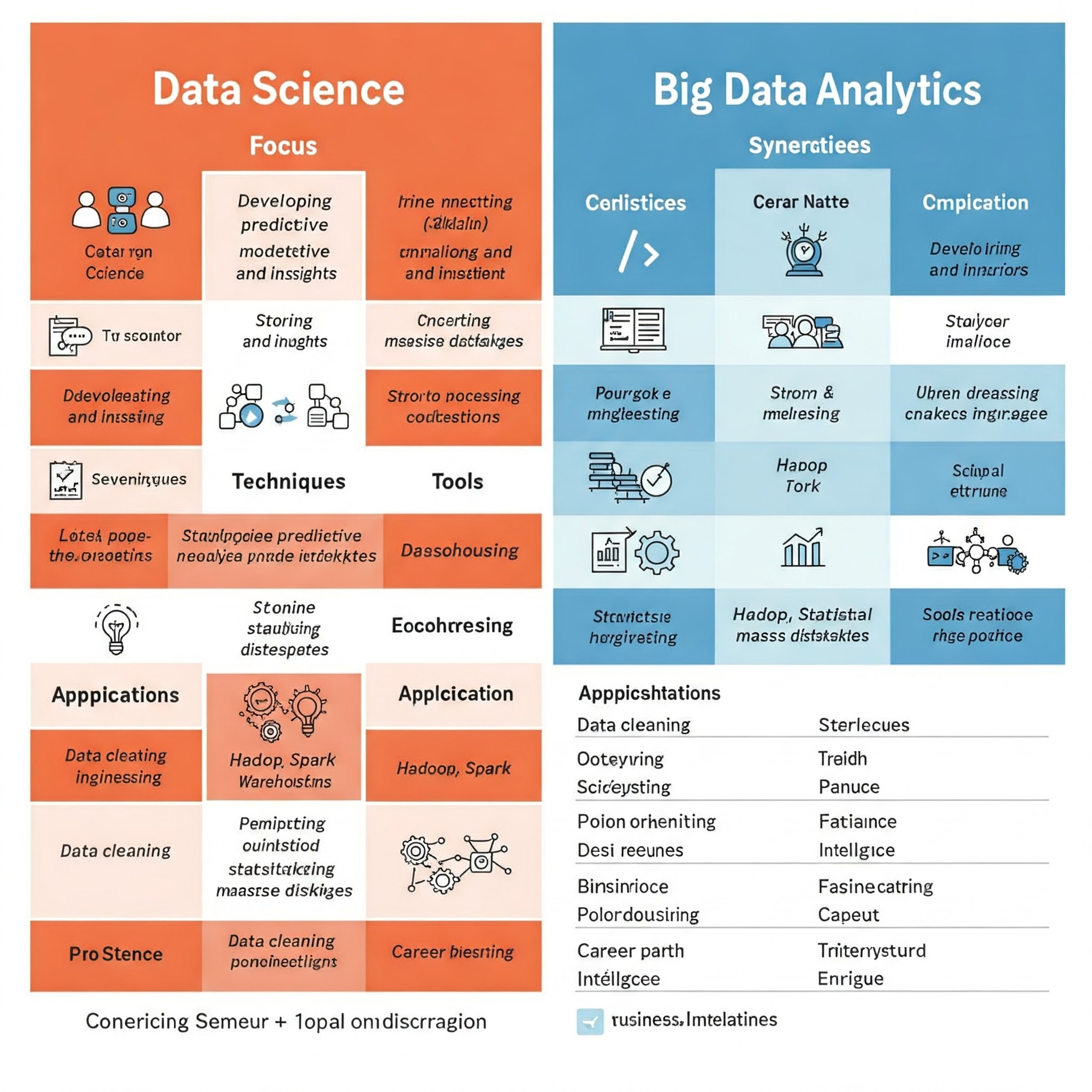In the modern business landscape, data has emerged as perhaps the most valuable asset an organization can possess. Yet raw data alone holds little value until it’s transformed into actionable insights that drive strategic decisions. The companies that have mastered this transformation—turning vast quantities of information into competitive advantages—are reshaping entire industries and setting new standards for business success.
The journey from data collection to decision-making represents one of the most significant business transformations of our time. Organizations that effectively harness data science and big data analytics are not just improving their operations; they’re fundamentally reimagining how business is conducted, creating new revenue streams, and delivering unprecedented value to customers.
The Strategic Imperative of Data-Driven Decision Making
Beyond Intuition: The Power of Evidence-Based Strategy
Traditional business decision-making often relied heavily on experience, intuition, and limited historical data. While these elements remain valuable, today’s successful organizations supplement them with sophisticated analytical capabilities that can process and interpret information at scales previously unimaginable.
Data-driven decision making enables organizations to identify patterns and trends that human analysis might miss, quantify risks with greater precision, and predict future outcomes with increasing accuracy. This shift from intuition-based to evidence-based strategy represents a fundamental evolution in how businesses operate and compete.
The Competitive Advantage of Real-Time Intelligence
In fast-moving markets, the ability to make informed decisions quickly can determine success or failure. Real-time analytics platforms enable organizations to respond to market changes, customer behaviors, and operational challenges as they occur, rather than discovering them weeks or months later through traditional reporting cycles.
Companies leveraging real-time data intelligence can adjust pricing strategies instantly based on demand fluctuations, optimize supply chains in response to disruptions, and personalize customer experiences at the moment of interaction. This agility creates sustainable competitive advantages that are difficult for slower-moving competitors to replicate.
Transforming Core Business Functions
Sales and Marketing Revolution
The impact of data science on sales and marketing has been transformative. Customer segmentation has evolved from broad demographic categories to micro-segments based on behavioral patterns, preferences, and predicted lifetime value. Marketing campaigns can now be personalized at the individual level, with content, timing, and channels optimized for each prospect’s unique profile.
Predictive analytics enables sales teams to prioritize leads based on conversion probability, while recommendation engines drive cross-selling and upselling opportunities with unprecedented precision. Marketing attribution models help organizations understand which touchpoints truly drive conversions, enabling more effective budget allocation and campaign optimization.
Amazon’s recommendation system exemplifies this transformation, driving approximately 35% of their revenue through personalized product suggestions. Netflix’s content recommendation algorithm not only improves user engagement but also informs content creation decisions, with data analytics playing a crucial role in determining which original series to produce.
Operations and Supply Chain Optimization
Manufacturing and logistics operations have been revolutionized through predictive maintenance, demand forecasting, and supply chain optimization. IoT sensors generate continuous streams of data about equipment performance, enabling organizations to predict failures before they occur and schedule maintenance during optimal windows.
Demand forecasting algorithms consider numerous variables including historical sales patterns, weather data, economic indicators, and social media sentiment to predict future demand with remarkable accuracy. This precision enables organizations to optimize inventory levels, reduce waste, and improve customer satisfaction through better product availability.
Walmart’s supply chain analytics platform processes over 2.5 petabytes of data hourly, enabling the company to optimize inventory placement, predict demand fluctuations, and coordinate logistics across thousands of locations. This capability has been instrumental in maintaining their position as a global retail leader.
Financial Services and Risk Management
The financial services industry has embraced data science to transform risk assessment, fraud detection, and customer service. Credit scoring models now incorporate hundreds of variables beyond traditional financial metrics, including social media activity, mobile phone usage patterns, and transaction behaviors.
Algorithmic trading systems process market data and execute trades in microseconds, while fraud detection systems analyze transaction patterns in real-time to identify suspicious activities. These applications have not only improved operational efficiency but also enabled financial institutions to serve previously underbanked populations and expand into new markets.
JPMorgan Chase’s COIN (Contract Intelligence) platform uses machine learning to analyze legal documents and extract key data points, reducing the time required for contract analysis from 360,000 hours annually to mere seconds. This transformation has freed up human resources for higher-value activities while improving accuracy and consistency.
Customer Experience and Personalization
Understanding the Customer Journey
Modern analytics platforms provide unprecedented visibility into customer behavior across all touchpoints. By tracking interactions across websites, mobile apps, social media, and physical locations, organizations can build comprehensive customer journey maps that reveal pain points, preferences, and opportunities for improvement.
This holistic view enables businesses to optimize each stage of the customer experience, from initial awareness through post-purchase support. Predictive models can identify customers at risk of churning, enabling proactive retention efforts, while sentiment analysis of customer feedback provides real-time insights into satisfaction levels and emerging issues.
Hyper-Personalization at Scale
The ability to deliver personalized experiences to millions of customers simultaneously represents one of the most powerful applications of big data analytics. Recommendation engines, dynamic pricing models, and personalized content delivery systems enable organizations to treat each customer as a segment of one while maintaining operational efficiency.
Spotify’s Discover Weekly playlist generates personalized music recommendations for over 100 million users each week, analyzing listening patterns, user preferences, and music characteristics to create unique experiences. This level of personalization has become a key differentiator in the competitive streaming market and drives significant user engagement and retention.
Innovation and Product Development
Data-Driven Innovation Cycles
Product development cycles have been accelerated and improved through data analytics. A/B testing platforms enable organizations to validate hypotheses quickly and iterate based on user feedback. Customer usage data reveals which features provide the most value, informing development priorities and resource allocation decisions.
Social media listening and sentiment analysis provide insights into customer needs and market gaps, while patent analysis and competitive intelligence help organizations identify emerging opportunities and threats. This data-driven approach to innovation reduces development risks and increases the likelihood of market success.
Predictive Product Development
Advanced analytics enable organizations to anticipate future customer needs and market trends. By analyzing usage patterns, demographic shifts, and technological developments, companies can develop products and services that meet emerging demands before competitors recognize the opportunities.
Tesla’s approach to vehicle development exemplifies this strategy, using data from their existing fleet to identify improvement opportunities and inform new feature development. Over-the-air updates enable continuous product enhancement based on real-world usage data, creating a feedback loop that drives ongoing innovation.
Operational Excellence and Efficiency
Process Optimisation and Automation
Data science applications have enabled organizations to identify inefficiencies and optimize processes across all functions. Workflow analysis reveals bottlenecks and redundancies, while predictive models help optimize resource allocation and scheduling decisions.
Robotic process automation (RPA) combined with machine learning enables organizations to automate complex decision-making processes that previously required human intervention. This automation not only reduces costs but also improves consistency and frees up human resources for strategic activities.
Quality Management and Continuous Improvement
Quality management systems enhanced with data analytics can identify patterns in defects, predict quality issues before they occur, and optimize processes to prevent problems. Statistical process control combined with machine learning algorithms enables real-time quality monitoring and adjustment.
This capability is particularly valuable in manufacturing environments where quality issues can have significant cost implications. By identifying and addressing quality problems early in the production process, organizations can reduce waste, improve customer satisfaction, and maintain brand reputation.
Measuring and Demonstrating ROI
Quantifying Business Impact
One of the challenges organizations face when investing in data science capabilities is demonstrating clear return on investment. Successful implementations require careful measurement and attribution of business outcomes to analytical initiatives.
Key performance indicators should be established before implementing data science projects, with clear baselines and success metrics defined. Regular measurement and reporting help organizations understand which initiatives provide the greatest value and inform future investment decisions.
Building the Business Case
Successful data science implementations require strong business cases that clearly articulate expected benefits and resource requirements. These business cases should consider both direct financial impacts and indirect benefits such as improved decision-making speed, reduced risk, and enhanced competitive positioning.
Organizations should also consider the opportunity costs of not investing in data science capabilities. In increasingly competitive markets, the ability to leverage data effectively can mean the difference between growth and decline.
Overcoming Implementation Challenges
Cultural Transformation
Perhaps the greatest challenge organizations face when implementing data science initiatives is cultural resistance to change. Many employees and managers are comfortable with traditional decision-making approaches and may be skeptical of analytical insights that challenge conventional wisdom.
Successful implementations require strong leadership commitment and clear communication about the value of data-driven decision making. Training programs, success stories, and gradual implementation can help build confidence and acceptance throughout the organization.
Data Quality and Governance
The success of any data science initiative depends on the quality and accessibility of underlying data. Organizations must invest in data governance frameworks that ensure data accuracy, consistency, and availability while maintaining appropriate security and privacy controls.
Data quality issues can undermine the credibility of analytical insights and reduce adoption of data-driven decision making. Establishing clear data standards, implementing quality monitoring processes, and creating accountability for data accuracy are essential for success.
Talent and Capability Development
The shortage of skilled data scientists continues to challenge many organizations. Successful implementations often require a combination of hiring external talent and developing internal capabilities through training and development programs.
Organizations should also consider alternative approaches such as partnerships with academic institutions, consulting firms, or technology vendors that can provide specialized expertise and accelerate implementation timelines.
Future Trends and Emerging Opportunities
Artificial Intelligence and Machine Learning Evolution
The integration of advanced AI and machine learning capabilities into business processes will continue to accelerate. Automated machine learning platforms are making sophisticated analytical capabilities accessible to non-technical users, while large language models are enabling new forms of data analysis and insight generation.
These developments will democratize data science capabilities and enable organizations to leverage analytical insights more broadly throughout their operations. However, they also require new approaches to governance, ethics, and risk management.
Edge Computing and Real-Time Analytics
The proliferation of IoT devices and edge computing capabilities is enabling real-time analytics at the point of data generation. This development will enable new applications in manufacturing, logistics, healthcare, and other industries where immediate insights can drive significant value.
Organizations that can effectively leverage edge analytics will gain competitive advantages through faster response times, reduced latency, and improved operational efficiency.
Ethical AI and Responsible Analytics
As data science applications become more pervasive and impactful, organizations must address ethical considerations and ensure responsible use of analytical capabilities. This includes addressing bias in algorithms, ensuring transparency in decision-making processes, and protecting customer privacy.
Regulatory frameworks around AI and data use will continue to evolve, requiring organizations to balance innovation with compliance and ethical considerations.
Conclusion: The Path Forward
The transformation from data to decisions represents more than a technological upgrade—it’s a fundamental shift in how organizations operate and compete. Companies that successfully navigate this transformation will find themselves better positioned to respond to market changes, serve customer needs, and drive sustainable growth.
Success requires more than just technology implementation. Organizations must develop the right capabilities, establish appropriate governance frameworks, and foster cultures that embrace data-driven decision making. The investment required is significant, but the potential returns—in terms of operational efficiency, customer satisfaction, and competitive advantage—justify the effort.
As we look toward the future, the organizations that will thrive are those that can effectively bridge the gap between data and decisions, turning information into insights and insights into action. The journey may be complex, but the destination—a truly data-driven organization—offers unprecedented opportunities for business success and market leadership.
The question is not whether organizations should embrace data science and big data analytics, but how quickly and effectively they can transform their data into a sustainable competitive advantage. In an increasingly data-driven world, this transformation is not just an opportunity—it’s an imperative for long-term success.
At 7Shades Digital, we specialised in creating strategies that help businesses excel in the digital world. If you’re ready to take your website to the next level, contact us today!





